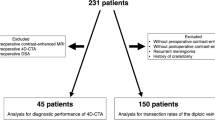Abstract
Purpose
To date, very few studies have explored the three-dimensional architecture of calvarial diploic venous channels (CDVCs). This study aimed to characterize the three-dimensional architecture of CDVCs using maximum intensity projection (MIP) images based on contrast-enhanced magnetic resonance imaging (MRI).
Methods
A total of 77 patients with intact calvarial hemispheres and underlying dura mater and dural sinuses underwent contrast-enhanced MRI. Among them, we extracted the data of 49 with at least a part of the major CDVC pathways identified on the MIP images for analysis.
Results
On serial contrast-enhanced MRI images, the CDVCs were commonly detected as curvilinear structures with inhomogeneous diameters and tributaries, while the MIP images delineated the three-dimensional architecture of the developed CDVC pathways. More than such CDVC pathway was entirely delineated on the right in 67.3% and on the left in 71.4%, most frequently in the frontal and temporal regions, with their connecting sites to the sphenoparietal and superior sagittal sinuses. The morphology, distribution, and course of the identified CDVCs were highly variable. In 55.1%, the CDVCs formed fenestrations that were variable in size, shape, and number.
Conclusions
The developed CDVC pathways may be characterized by morphological variability and fenestrations. Thin-sliced, contrast-enhanced MRI is useful to depict diploic veins, while MIP images allow for better appreciation of the entire course of the developed CDVC pathways. Traumatic and intraoperative disconnection between the dura mater overlying the dural sinuses and the adjacent inner table of the skull can cause epidural venous bleeding.







Similar content being viewed by others
References
Cao R, Jiang Y, Lu J, Wu G, Zhang L, Chen J (2020) Evaluation of intracranial vascular status in patients with acute ischemic stroke by time maximum intensity projection CT angiography: a preliminary study. Acad Radiol 27:696–703
García-González U, Cavalcanti DD, Agrawal A, Gonzalez LF, Wallace RC, Spetzler RF, Preul MC (2009) The diploic venous system: surgical anatomy and neurosurgical implications. Neurosurg Focus 27:E2
Gregori F, Santoro G, Mancarella C, Piccirilli M, Domenicucci M (2019) Development of a delayed acute epidural hematoma following contralateral epidural hematoma evacuation: case report and review of literature. Acta Neurol Belg 119:15–20
Hassan MF, Dhamija B, Palmer JD, Hilton D, Adams W (2009) Spontaneous cranial extradural hematoma: case report and review of literature. Neuropathology 29:480–484
Huang YH, Lee TC, Lee TH, Yang KY, Liao CC (2013) Remote epidural hemorrhage after unilateral decompressive hemicraniectomy in brain-injured patients. J Neurotrauma 30:96–101
Jivraj K, Bhargava R, Aronyk K, Quateen A, Walji A (2009) Diploic venous anatomy studied in-vivo by MRI. Clin Anat 22:296–301
Lim JW, Yang SH, Lee JS, Song SH (2010) Multiple remote epidural hematomas following pineal gland tumor resection. J Pediatr Neurosci 5:79–81
Mallouhi A, Felber S, Chemelli A, Dessl A, Auer A, Schocke M, Jaschke WR, Waldenberger P (2003) Detection and characterization of intracranial aneurysms with MR angiography: comparison of volume-rendering and maximum-intensity-projection algorithms. AJR Am J Roentgenol 180:55–64
Ng WH, Yeo TT, Seow WT (2004) Non-traumatic spontaneous acute epidural hematoma–report of two cases and review of the literature. J Clin Neurosci 11:791–793
Paiva WS, Oliveira AM, de Andrade AF, Brock RS, Teixeira MJ (2010) Remote postoperative epidural hematoma after subdural hygroma drainage. Case Rep Med 2010:417895
Pandey P, Madhugiri VS, Sattur MG, Devi BI (2008) Remote supratentorial extradural hematoma following posterior fossa surgery. Childs Nerv Syst 24:851–854
Rangel de Lázaro G, de la Cuétara JM, Píšová H, Lorenzo C, Bruner E (2016) Diploic vessels and computed tomography: Segmentation and comparison in modern humans and fossil hominids. Am J Phys Anthropol 159:313–324
Rice JO, Walters C, Olson RE, Pearson D (1976) Epidural hematoma after minor oral trauma. J Oral Surg 34:639–641
Teramoto S, Tsutsumi S, Ishii H (2020) Traumatic acute epidural haematoma caused by injury of the diploic channels. Surg Neurol Int 11:333
Tsutsumi S, Nakamura M, Tabuchi T, Yasumoto Y, Ito M (2013) Calvarial diploic venous channels: an anatomic study using high-resolution magnetic resonance imaging. Surg Radiol Anat 35:935–941
Tyagi G, Bhat DI, Devi BI, Shukla D (2019) Multiple remote sequential supratentorial epidural hematomas-an unusual and rare complication after posterior fossa surgery. World Neurosurg 128:83–90
Xu GZ, Wang MD, Liu KG, Bai YA (2014) A rare remote epidural hematoma secondary to decompressive craniectomy. J Craniofac Surg 25:17–19
Yamaguchi-Okada M, Fukuhara N, Nishioka H, Yamada S (2014) Remote extradural haematomas following extended transsphenoidal surgery for a craniopharyngioma–a case report. Br J Neurosurg 28:694–696
Yamakawa K, Naganawa S, Maruyama K, Kato T, Fukatsu H, Ishigaki T (1999) Clinical evaluation of three-dimensional MR-cholangiopancreatography using three-dimensional Fourier transform fast asymmetric spin echo method (3DFT-FASE): usefulness of observation by multi-planar reconstruction. Radiat Med 17:15–19
Yoneoka Y, Watanabe M, Nishino K, Ito Y, Kwee IL, Nakada T, Fujii Y (2008) Evaluation of post-procedure changes in aneurysmal lumen following detachable coil-placement using multi-planar reconstruction of high-field (3.0T) magnetic resonance angiography. Acta Neurochir 150:351–358
Funding
No funding was received for this study.
Author information
Authors and Affiliations
Contributions
ST conceived the study and wrote the manuscript.HO collected the imaging data. ST and HI analyzed the imaging data.
Corresponding author
Ethics declarations
Conflict of interest
The authors have no conflicts of interest to declare regarding the materials or methods used in this study or the findings presented in this paper.
Ethical approval
All procedures in this study were performed in accordance with the ethical standards of the institutional and/or national research committee and the 1964 Declaration of Helsinki and its later amendments or comparable ethical standards.
Informed consent
Informed consent was obtained from all participants included in the study.
Additional information
Publisher's Note
Springer Nature remains neutral with regard to jurisdictional claims in published maps and institutional affiliations.
Rights and permissions
About this article
Cite this article
Tsutsumi, S., Ono, H. & Ishii, H. Calvarial diploic venous channels: delineation with maximal intensity projection technique. Surg Radiol Anat 43, 1319–1325 (2021). https://doi.org/10.1007/s00276-021-02729-2
Received:
Accepted:
Published:
Issue Date:
DOI: https://doi.org/10.1007/s00276-021-02729-2




